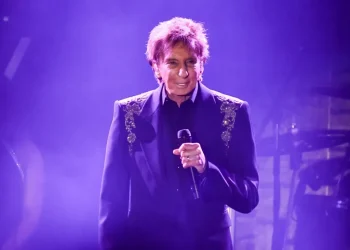Netflix’s The Perfect Couple and the Rise of ‘Mid TV’: Why TV Felt Underwhelming in 2024
As we reflect on the TV shows of 2024, many viewers may find themselves suffering from a collective memory lapse. What was that crime series on Apple TV+ with the big-name actor? Was it Presumed Innocent or Sugar? What about that charming rom-com starring Adam Brody? Did you watch the one where Nicole Kidman, draped in high-end fashion, floated around worried about her missing son (The Expats)? Or maybe the show where she, once again in designer dresses, played a woman concerned about a murder on her estate (The Perfect Couple)?
If you realized, after a quick search, that The Perfect Couple was one of your 2024 TV binges, you’re not alone. This show, which dropped on Netflix in September, is the epitome of a certain TV phenomenon that defined this year. A glossy, soapy murder mystery based on Elin Hilderbrand’s novel, The Perfect Couple brought together a decent cast, including Nicole Kidman, Liev Schreiber, Meghann Fahy, and Dakota Fanning. The six-episode series took viewers to Nantucket, where an upper-class wedding spirals into a murder investigation.
The tone of the show, however, felt disjointed. Was it a melodramatic, telenovela-style thriller, or was it a satire of the genre? This confusion lingered, alongside an awkward beach dance routine set to Meghan Trainor’s song Criminals, which was awkwardly included at the start of each episode. Meghann Fahy herself admitted the cast had no idea why they were doing it. Yet, despite its offbeat tone, The Perfect Couple hit the top of Netflix’s TV charts for two consecutive weeks, only to be quickly forgotten.
“I had actually forgotten I had watched The Perfect Couple,” says Manori Ravindran, a TV industry journalist. “All I can remember is the dance, which felt like a forced effort to make the show memorable. It’s a perfect example of ‘Mid TV’.”
What is ‘Mid TV’?
The term ‘Mid TV’ was first coined by New York Times journalist James Poniewozik in April 2024. He suggested that the so-called “Golden Age of TV” had ended, marking the rise of shows that are visually appealing, feature A-list talent, and are enjoyable enough, but ultimately, are forgettable. Poniewozik identified this trend in shows like Palm Royale (Apple TV+), Platonic (Apple TV+), Mr. & Mrs. Smith (Amazon), and Poker Face (Peacock).
“Mid TV is what you get when you raise TV’s production values and lower its ambitions,” Poniewozik wrote. “It substitutes great casting for great ideas. It looks great on the big screen but lacks substance. It’s good enough, but forgettable.”
Ravindran believes that Mid TV has become a major force in 2024. “It’s all about big stars, generic characters, and recycled storylines,” she tells the BBC. “Nothing stands out, and nothing sticks with you.”
As more Mid TV shows flood the market, particularly from streaming giants like Netflix, Apple TV+, and Amazon, many cynics see moves like the beach dance routine in The Perfect Couple as a tactic to make the show stand out in a sea of mediocrity.
Is Mid TV Really That Bad?
While some may bemoan the rise of Mid TV, it’s not necessarily a bad thing, argues TV critic Dan Barrett. “TV’s true strength is in helping people unwind,” Barrett says. “While prestige shows are great for a deep, intellectual experience, the majority of viewers just want something light and easy after a long day. Mid TV fills that gap—it’s entertaining without being too taxing.”
Why Creativity Has Declined
There are several reasons for the rise of Mid TV, according to Ravindran and Barrett. One of the primary factors is the overwhelming demand for content from streaming platforms. “Streaming services want to churn out high volumes of content that look spectacular but often lack depth,” says Barrett. “These shows are often just ideas stretched thin, running 8 to 10 episodes when they could have been condensed into a two-hour film.”
Additionally, streaming services have faced financial challenges. In 2022, Netflix lost nearly a million subscribers, which marked a turning point. With pressure to maintain profitability, streaming platforms became more cautious in their programming choices, resulting in more formulaic and safe-bet series. As Netflix’s VP Jinny Howe put it, their goal became to create a “gourmet cheeseburger”—something that’s both “premium and commercial.”
Despite cutting back on spending, Netflix’s revenues in 2023 grew by 7%, while their subscriber base swelled to 282.7 million. The Mid TV strategy is working, financially speaking, even if it feels like an uninspired approach to creativity.
The Superficial Allure of Wealth and Celebrity
Another trend that has defined 2024 is the increasing number of shows focused on the lives of the ultra-wealthy. While shows like The White Lotus and Succession have explored these environments with dramatic depth, many new shows merely use wealth as a backdrop, offering little more than gorgeous settings and expensive interiors. As Vinson Cunningham of The New Yorker observed about The Perfect Couple: “It’s doubling past media – not critiquing it, but merely imitating it.”
The Future of TV: Will Prestige Return?
While Mid TV seems to be here to stay, the future of more innovative, prestige TV isn’t entirely bleak. Shows like Kaos, a Greek mythology drama on Netflix, have pushed boundaries, even if it was quickly canceled after only one season. Industry observers like Ravindran predict that more prestige content will emerge in 2025, particularly with upcoming releases like The Harry Potter Show on Max (formerly HBO Max).
However, Barrett believes the focus will shift towards “returnable dramas”—episodic shows that are easier to jump into without needing to follow a complex, overarching plot.
Despite the rise of Mid TV, more ambitious projects will continue to emerge, even if they become more niche. “The streaming world is still churning out great series,” says Jesse Whittock, international TV co-editor at Deadline. “We’re seeing some of the most innovative shows in years, but they may not be for everyone.”
Conclusion
So, while the rise of Mid TV may be a sign of the times, it’s not necessarily a death knell for quality television. Yes, we’re seeing more generic, formulaic shows, but at the same time, viewers are still flocking to them. If Mid TV helps meet the demands of the modern audience while keeping streaming services financially viable, it’s a trend that will likely continue. But for those seeking something more groundbreaking, it may be a quieter, more niche corner of the television landscape where true innovation continues to thrive.
This article was rewritten by JournosNews.com based on verified reporting from trusted sources. The content has been independently reviewed, fact-checked, and edited for accuracy, neutrality, tone, and global readability in accordance with Google News and AdSense standards.
All opinions, quotes, or statements from contributors, experts, or sourced organizations do not necessarily reflect the views of JournosNews.com. JournosNews.com maintains full editorial independence from any external funders, sponsors, or organizations.
Stay informed with JournosNews.com — your trusted source for verified global reporting and in-depth analysis. Follow us on Google News, BlueSky, and X for real-time updates.














